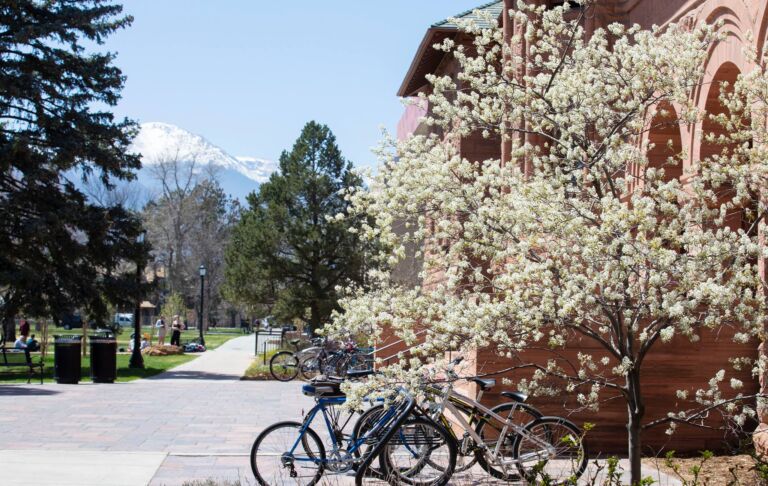
IMAGE from Colorado College
Anyone who has taken a gap year or is somehow connected to the gap year community is familiar with the myriad benefits of doing so. Students who take a gap year between high school and college are almost invariably more mature, more focused, and more likely to take advantage of the full undergraduate experience from the start of their first year. It has also almost become conventional wisdom that doing something different for a semester or a year can be liberating from the lock-step mentality with which most students approach their high school experience. A gap year can help students discover for themselves where their true talents and passions lie. For that reason, ideally students complete the college admissions process before taking a gap year. That way, the admissions process is behind them and they can focus on what’s truly important to them.
Up to now, the evidence for these benefits of taking a gap year has been compelling but largely anecdotal, and the growth of interest in taking a gap year has been largely dependent upon word-of-mouth. However, as colleges and universities have come to recognize for themselves that students who have taken a gap year bring even more to their educational and other endeavors in college, a few institutions began studying the effects of taking a gap year with their own research projects. Middlebury College (VT) and the University of North Carolina at Chapel Hill were among the first to do so, looking at the undergraduate academic performance of gap year students. A few other institutions did their own gap year-related research on other topics, comparing graduation rates of gap year students to others, and even looking at disciplinary rates of gap year students compared to others. However, these projects were largely undertaken in their own institutional vacuums, with little attempt to disseminate their research outcomes to the broader educational community and the public.
Thus was born the Gap Year Research Consortium at Colorado College (GYRC) in 2019. The Consortium is a group of colleges and universities around the United States interested in encouraging more gap year research and creating a clearinghouse to share gap year research methodologies, data, and outcomes and eventually distributing this information widely through journal articles and the public press. At this point the GYRC has 12 member institutions: Bennington, Case Western, Colorado College, Denison, Duke, Florida State, Harvard, Lafayette, the University of Oregon, Portland State (OR), Stanford, and Tufts. Colorado College provides a Principal Investigator from its faculty and a Coordinator to oversee the Consortium’s research projects, and the Consortium has a seven-member Advisory Board comprised of experts in educational research and others interested in the gap year movement. The Consortium also has its own website at Colorado College here.
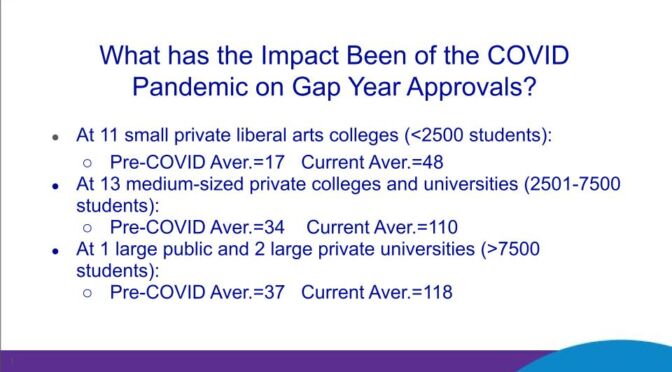
As a result of the COVID-19 pandemic and the effect that it has had this year on the number of students requesting to take a gap year, it turns out that this is also a particularly propitious time to be doing gap year research. In fact, late in the summer of 2020, the Consortium sent out a brief survey to a group of institutions, asking for their typical number of pre-COVID gap year requests and their current numbers, along with information about their size, governance, and any changes in their gap year policies. As shown in the chart to the left, the increase in gap year requests this year was in the range of three-fold at all three undergraduate enrollment size groups
For its first research project in 2020, the Consortium decided to replicate the methodology first designed at Middlebury in 2011 and replicated at UNC-Chapel Hill to examine the impact of taking a gap year on academic performance in college. In that study, the average GPAs of gap year students were first compared to those of non-gap year students for the four years of classes that were enrolled during academic year 2010-11. These charts show four years of average GPA data for the Class of 2011, three years for the Class of 2012, two years for the Class of 2013, and only first-year year data for the Class of 2014.
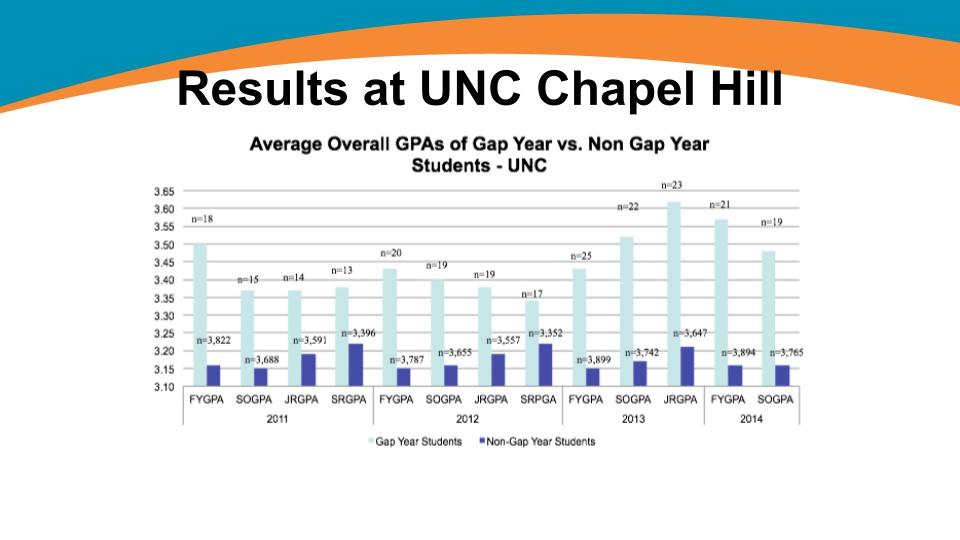
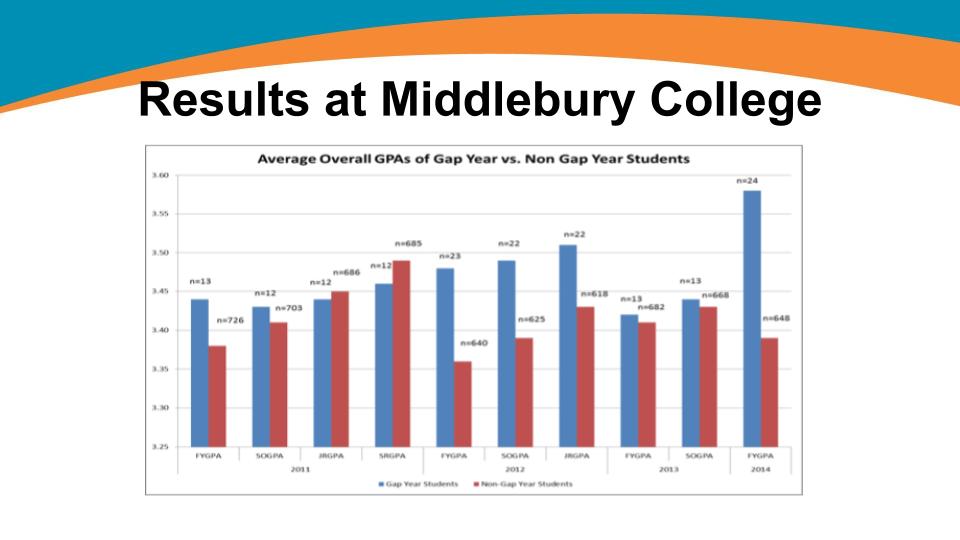
While showing generally much stronger academic performance by gap year students compared to non-gap year students, these results were not especially surprising, since students who take gap years have traditionally come from more affluent families and attended more highly-resourced high schools. For that reason the study looked more closely at the academic performance of gap year students alone, comparing their actual GPAs with the GPAs that would have been predicted, controlling statistically for the academic rating which those students received in the admissions process, which is based on high school grades, academic rigor of their curriculum, standardized test scores, teacher recommendations, etc. Most selective institutions’ admissions offices use some form of rating system like this, and it provides by far the best predictor of academic performance in college.
The two charts below show the amount by which gap year students’ actual average GPAs differed from that which would have been predicted, based on their academic rating in the admissions process. Almost all gap year cohorts showed a pattern of over-performance over all the years for which GPA data was available. The darker bars on each chart show the results that were statistically significant for those years.
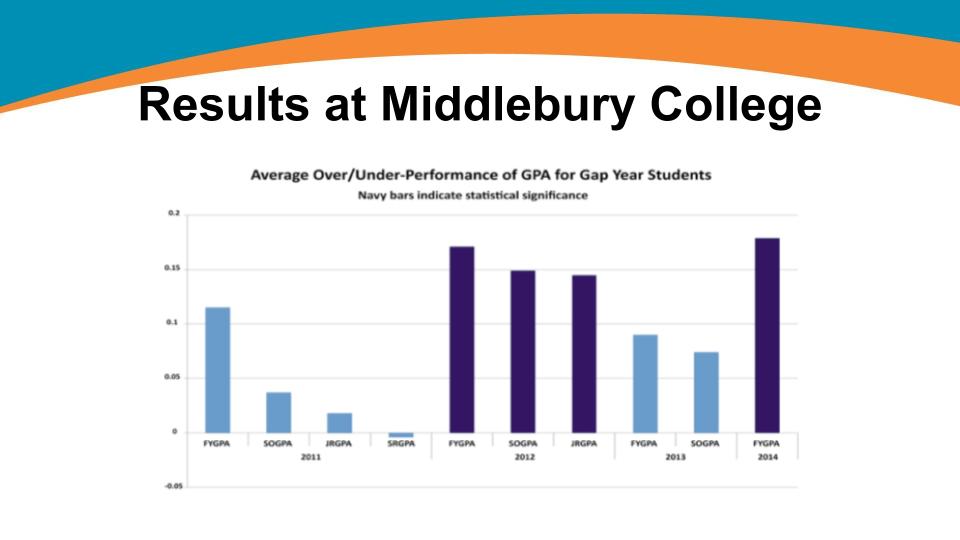
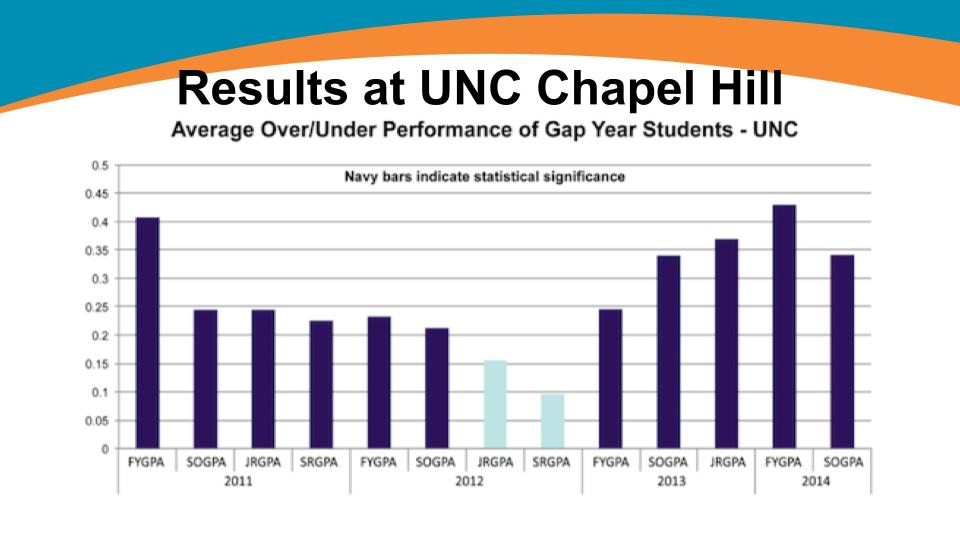
In contrast with the common concern that students who take a gap year may lose their academic momentum and perform less well in college, these charts show that just the opposite is true. On average, most students who take a gap year end up performing at higher levels than would have been predicted. Other studies have shown that they are also not only more likely to return to an academic track after their gap years, but they are also more likely to engage meaningfully with their college courses.
When the Gap Year Research Consortium decided last year to replicate this methodology for its own first research project, four member institutions joined the study. This chart, on the right, shows the amount of overperformance by gap year students in the Class of 2021 during their first three years at each of the participating institutions.
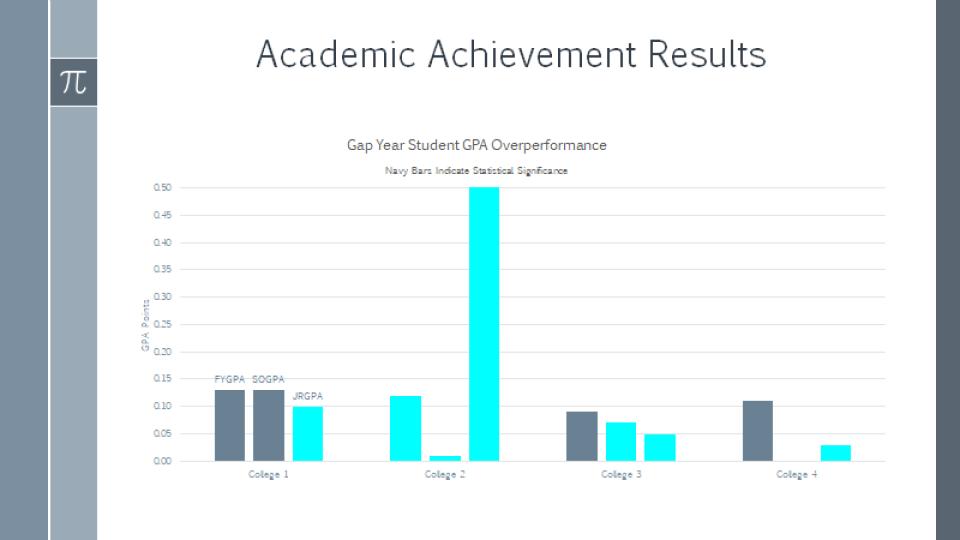
While these results were somewhat less consistent than those from the original Middlebury/UNC-Chapel Hill study, they still show a pattern of over-performance by gap year students, and the positive influence remains in effect for all three years for which we had data. Please note also that because some of the sample sizes of gap year students were smaller at these participating institutions, it was more difficult to show statistical significance for all years
next steps for the consortium
Academic performance in college is, of course, only one of many positive effects of taking a gap year that can be studied. The Consortium has recently launched a longitudinal study, using this year’s larger gap year cohort, to look at the impact of taking a gap year on students’ social, emotional, and behavioral health in college. The results of that study will not be available for several years, but we are currently also designing a survey to distribute to students taking a gap year this year at both member and non-member institutions, asking them questions such as:
How much did the COVID-19 pandemic affect your decision to take a gap year?
What did you do with your gap year? What did you gain from it?
Did your gap year have any impact on your college plans, etc.
This should provide us with important data to help us evaluate the impact of taking a gap year on this year’s much larger group of students, and we hope to publish the results of this study next summer.
If you work with an institution that is not a member institution of the Consortium and you are interested in participating in the Consortium’s research, please reach out to Bob Clagett, Coordinator of the Consortium, Gap Year Association Board Member and GYA Research Committee member, at bclagett@coloradocollege.edu. To learn more about the Consortium, please visit their website. Learn more about requirements for participation and engagement, should you wish to sign on as a Consortium member institution.
Categories
- Advising (6)
- Alumni (2)
- Career (4)
- College & University (13)
- Communication (17)
- DEIA (4)
- Fair Trade Learning (3)
- Finances (11)
- Gap Year Benefits (66)
- Growth & Development (5)
- Leadership (5)
- Learning & Reflection (53)
- Mental Health (3)
- Planning (57)
- Professional Development (4)
- Research (3)
- Risk Management (3)
- Safety (5)
- Service-Learning (10)
- Standards & Accreditation (1)
- Sustainability (6)
- Voices Project (20)
